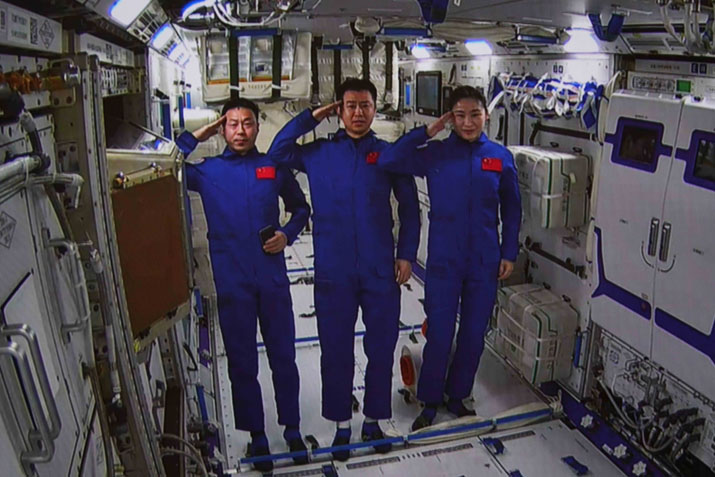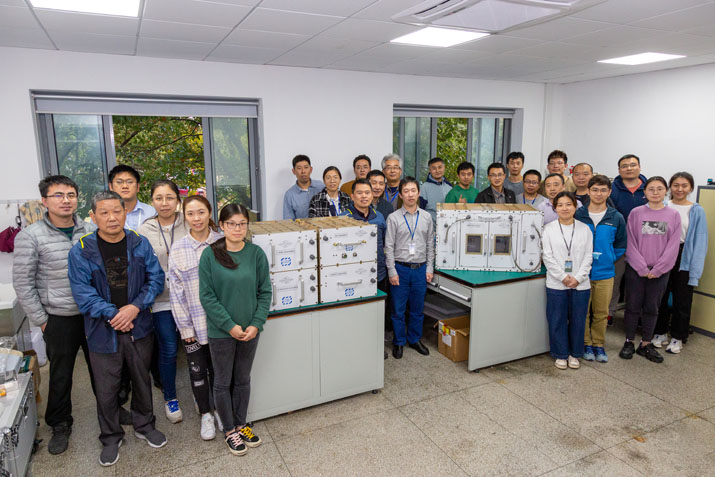Wentian successfully docked with core module Tianhe of China's space station some 400 km above Earth in the early morning of July 25. Several hours later, the three taikonauts already in the core module entered the lab module to check it out.
Wentian, weighing 23 tons before taking off and measuring 17.9 meters in length and 4.2 meters in maximum diameter, is China's largest spacecraft ever sent into Earth's orbit.
Consisting of a work cabin, an airlock cabin and a resource cabin, the lab module serves as a backup of the core module and a platform for scientific experiments. It is an important part of China's space station, the in-orbit construction of which began last April and is scheduled to be complete by the end of this year.

Taikonauts in China's space station pose after entering the Wentian space lab on July 25 (XINHUA)
A scientific platform
The lab module was designed primarily for life science and biotechnology research. Experiments will be carried out for studying the growth, aging and genetic traits of plants and animals as well as microbes in the space environment.
Wentian houses several scientific cabinets, each with a height of 1.8 meters, width of about 1 meter, and depth of 0.8 meter, for extensive purposes, Lu Congmin, deputy chief designer of the space application system of China's manned space program, told Xinhua News Agency.
The bioecology and biotechnology cabinets, each with subunits for conducting experiments, were developed by the SITP, which is a research institute under Chinese Academy of Sciences.
Zhang Tao, a research fellow with the SITP, said experiments on the space station are usually carried out in three ways—automatically by the experiment systems following predetermined procedures, remotely controlled from ground, and manually by astronauts.
"At present, as the astronauts are not professional scientists, experiments should be designed to be automatically done as much as possible," he said. "We also train astronauts on the ground, so that they can complete the parts that must be done manually according to the operating manuals."
In the SITP's science cabinets, scientists have installed sophisticated microscopes that can automatically track and zoom in on the objects under study, as well as sensors to record and report data. Oxygen and water can also be added into the experiments according to commands issued from Earth.
The bioecology cabinet is for growing creatures such as Arabidopsis (rockcress), fruit flies and zebrafish to study the effects of the microgravity environment on them. In one subunit of the cabinet is the fish tank, a closed aquatic ecosystem. "In the microgravity environment of space, the tank must be airtight, otherwise water will fly away," Tian said.
In the miniature ecosystem, aquatic plants produce oxygen for fish while fish exhale carbon dioxide to be used by aquatic plants for photosynthesis, and microbes serve as decomposers. The ecosystem is expected to be a naturally balanced one, yet if the balance is broken, a life support system is available to intervene. Upon completion of the experiment, fish eggs will be collected and brought back to Earth.
Such a simplified aquatic ecosystem will shed light on building ecological systems on the Moon and Mars in the future so as to provide astronauts with food, water and oxygen, Zheng Weibo, a SITP researcher, said.
While some experiments are future-oriented, others may help unlock the mystery around the development of early life on Earth.
"Human beings are unable to return to billions of years ago when the seeds of life were produced to trace their extraterrestrial origin, however the space station environment featuring microgravity and strong radiation provides a similar environment to the primitive Earth," Ding Kun, an electronics engineer with the SITP, said.
The biotechnology cabinet is for experiments on molecules, cells, tissues and organs. Lu said these experiments will help people understand cell growth and differentiation under microgravity, the origin and evolution of life, as well as high-efficiency protein, polypeptide drugs, and nanocrystalline bone materials.
The science glovebox provides a clean and confined space for astronauts to conduct experiments, the cryogenic storage cabinet can store samples at low temperatures, and the variable gravity experiment cabinet can simulate lunar gravity, Martian gravity and other different gravity levels.
In addition to the cabinets, some payloads are put outside the module to record data of space particles and some to study the performance of materials such as lubricants in the space environment.
More than a lab
Wentian is more than a science lab. "In addition to its scientific functions, Wentian also serves as a backup control station to Tianhe in case of emergencies or malfunctions. It has all the same flight-control devices as those inside the core module to operate the entire the Tiangong space station," Zhang Qiao, head designer of Wentian's overall structure, told China Daily.
The lab module also has three separate sleeping quarters to accommodate astronauts and a personal hygiene section.
It has a 5-meter robotic arm that is noted for its precision and flexibility. The device can carry up to 3 tons of payload, and can be linked with a 10-meter robotic arm on the core module to create a joint arm capable of reaching all major parts of the space station, Zhang said.
Wentian's airlock cabin, with a wider hatch and inner space than the one on the core module, will be used as the main exit-entry point for extravehicular activities when the space station is completed, according to Zhang.
With two flexible solar panels that in total can stretch up to 55 meters long and cover more than 200 square meters, Wentian can generate enough electricity to power the entire space station, Zhang Hao, a researcher with the Fifth Academy of China Aerospace Science and Technology Group, told Xinhua.
Upon completion, the Tiangong station will have one core module and two lab modules, with the other lab module Mengtian set to be launched in October. Mengtian will serve microgravity scientific research, with experiment cabinets for the study of the physics of fluids, material science, combustion science and basic physics, according to the China Manned Space Agency.
Before its completion at the end of this year, Tiangong will be visited by the cargo-shipping Tianzhou-5 and three more taikonauts ferried by space shuttle Shenzhou-15.
(Print Edition Title: Exploring Life in Orbit)















